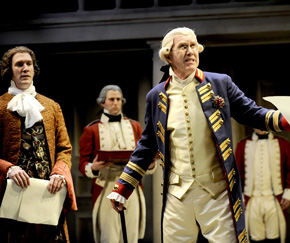
In Alan Bennett's big-cast historical drama, The Madness of George III, the stage picture often resembles (to our yankee eyes, anyway) portraits of our nation's Founding Fathers—aka "old men in white wigs". The primary reason for this déjà vu is the play's setting in late 18th century England, when fashionable members of the royal court habitually sported abundant tresses, real or false, crimped into various shapes and floured to a chalky hue. Beyond period authenticity, however, the multiplicity of artificial coiffures are also necessitated by double, or even triple, casting—an expediency requiring actors to exit as one character, only to appear seconds later as another.
Add to these elements the reluctance of many modern actors to follow our ancestors' practice of shaving their heads to facilitate hygiene in proximity with headgear that was, in those less fastidious times, hot, heavy or even vermin-infested, and Melissa Veal, Chicago Shakespeare Theater's resident wig designer, clearly has her work cut out for her.
Some of the male characters are seen onstage without their wigs, and so, Veal explains, they are given "hedge hog haircuts (very short as per the period)". The other actors in the show tuck their own hair away however they prefer, using headbands or surgical elastic to increase the gripping strength. Even with these preparations, however, the wigs can become very warm—so much that "the men in the very large yak hair wigs take them off when they are not on stage."
Did she just say yak hair? "In this show, we have three different wigs. Yak hair, human hair and synthetic. The lace caps are wefted with one of these three kinds of hair." But George III also calls for wigs that are supposed to look like wigs, and for these, Veal and her staff converted several ready-mades into hard-front wigs—where the hair stops abruptly in a rolled edge, as opposed to lace-fronts, where the strands are blended into a hairline attached to a transparent base that is then glued to the wearer's forehead.
Obviously these wigs are not the one-size-fits-all affairs available in beauty shops. Of course, says Veal, it's "great" if an actor's wig size should happen to match something already in the theater's stock, but otherwise, a head-wrap measuring the actor's head from every angle ascertains that each wig is fitted to the individual wearer. "They [the wigs] need daily maintenance, [so] the rolls are kept in place with bobby pins."
And what does "daily maintenance" entail? "The wig laces are cleaned with 91% isopropyl alcohol after every performance. Some are washed once in a while for re-sets. I always...try to make it as cool and comfortable as possible for the actors."
The Madness of George III runs through June 12 at Chicago Shakespeare Theater at Navy Pier.
Mary Shen Barnidge
Contributing Writer

 Follow Us On Twitter
Follow Us On Twitter